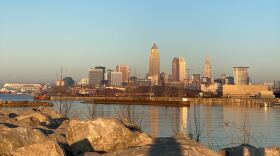Cleveland City Council and Mayor Justin Bibb appear to have reached a compromise over where funds from Downtown’s proposed tax district should go.
Earlier this month, City Council said it wanted at least half the proceeds from the Downtown tax increment financed district to go to the city’s neighborhoods.
Now, Council says it’s reached an agreement with the Bibb administration to decrease that ask to 35%. The city estimates the TIF district will generate between $3.5 to $7.5 billion in new revenue over the next 42 years.
The proposed "Shore-to-Core-to-Shore" TIF district would funnel a portion of rising property taxes from much of Downtown and the near West Side to fund Bibb’s sweeping plan to develop river and lakefront projects, including a pedestrian land bridge and scenic lakefront overlooks.
“The TIF District will only work if we make upfront investments to transform our waterfronts and grow our downtown, which means we need to preserve flexibility to access all funding sources,” Bibb said in a written statement. “The TIF District will strengthen our downtown for generations to come, generating hundreds of millions of dollars to improve our neighborhoods.”
Bibb's proposal would also allow the city to use TIF money anywhere in the city. That means a Downtown TIF project could potentially fund a park in the Central neighborhood, according to Cleveland’s Development Chief Jeff Epstein.
“Our members look forward to ensuring the TIF District will produce real, tangible improvements for our neighborhoods and downtown," Council President Blaine Griffin said in a written statement. "Based on the framework we’re discussing, we anticipate that as much as 35% of the excess revenue could be used on public improvements in neighborhoods to spur continual and necessary progress for decades to come in our middle, edge, and opportunity neighborhoods, from Lee-Harvard to Central, and Collinwood to Kamm’s Corners.”
Council will hold committee hearings and approve the legislation after they conclude city budget hearings. Those begin next week.




